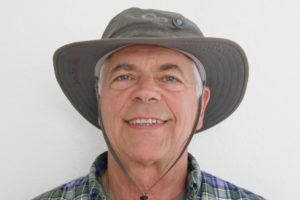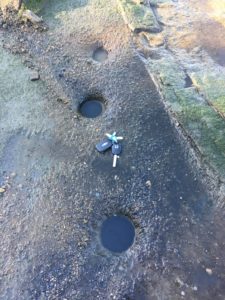Welcome to my first monthly column focused on local day hiking destinations, that with a little imagination, will take you back in time to when our local Native Americans lived in a garden of Eden we now call home.
My friends and I grew up hiking the hills around Orinda, Moraga and Mt Diablo. Dad (a TBF tail gunner) came back from the Battle of Midway with 112 holes in his plane. The Navy needed pilots, and sent him to St Mary’s College in Moraga for pre flight school. Dad loved it here and Mom wanted to live close to San Francisco, the “ Paris of America.” We moved to Orinda when I was a little guy. The area was much more rural. If we needed to go somewhere, we walked. I’ve been hiking those hills for over 50 years and I still haven’t seen everything of interest. For the last 34 years we’ve lived in Benicia enjoying our many local hiking destinations.
I hope you will have fun exploring, discovering, educating others and protecting our Native Village sites. You will be hiking to villages historians say are 10,000 years old. I will also write about hiking to other local early Californian history sites of interest, some High Sierra locations, and perhaps a unique watering hole for an end of the day refreshment.
If you want to get a jump start on hiking to these Village sites, go to www.eastbayhillpeople.com to read about them. I will be referencing this resource often and encourage you to also use it for even more hiking destinations and information. This wonderful site is the work of my friends James Benney and Robert Bardell who introduced me to this new world, and I can’t thank them enough. I also want to thank Tom Stienstra, an outdoor writer for the San Francisco Chronicle and SF Gate who has been very supportive. Tom has been doing this for years and I encourage you all to read his books and columns.
As hikers and explorers, we have found or visited a stone birthing chair, pestles still in mortars, menstruation and birthing camps with sitz baths, ceremonial pathways, ceremonial gathering sites, stone hunting walls, obvious wickiup locations, a cave with petroglyphs on Mt. Diablo, and more. I would encourage and ask that you “leave no trace” and never take anything you may happen to find. I will not give GPS readings or write about sensitive sites or the location of artifacts. But, I do feel that if there is a Village Site located in a public park or recreation area, we as tax payers, have the right to enjoy and tell others about them.
I find hiking a most rewarding experience for the whole family, and there is nothing like having a picnic where the ancients lived and in which the environment hasn’t changed very much for thousands of years. It also makes for a great inexpensive date!
I hope you will enjoy your journey back in time visiting our Native American’s home sites in their garden of Eden. Please be respectful of where you travel.
So, how does one know when you’re in a Native Village site? It’s really pretty easy. Just look for bedrock mortars, which are holes of various sizes and shapes, ground into the bed rock using pestles (hand held rocks) to grind grains, seeds, fish, meats, acorns, herbs for cooking and medical use. They are generally by a water source used for processing these resources and of course for drinking. However, many mortars have been found at observation sites that afford great views of the surrounding territory and also in areas of seasonal harvesting opportunities. There may be hundreds of them at a permanent Village, as is the case in Morgan Territory Regional Park where there are over 700 mortars, supporting upwards of 350 souls. This Village is located just a few yards off a main fire road, less then a mile from the parking lot. Or, you may only find one mortar, found in a cave, a short one block walk along a beautiful creek in the Walnut Creek open space area.
Our environment has greatly changed over the last 10,000 years. Several sites have many mortars but the location is dry as a bone. However, a closer look reveals ancient creek beds and waterfalls waiting for the song of water to return.
Our first Village hike is to “Sogorea Te.” It’s very easy, 1/4 mile in length, and right in our back yard. Located in Glen Cove, right by the water, with a great beach, sun bathing opportunities and is also kid and dog friendly. It was in the news in 2011 because local Ohlone Indians consider it a sacred site. The Ohlones are right, so please be respectful. The Village site is beautiful and right next to a creek, so it’s easy to see what a natural location this is. It is also where the Ohlone crossed the river to present day Crockett, which was a major Village site of around 400 souls. You’ll need to visit when the tide is out a bit to see the mortars, which tells me that the river was possibly several feet lower, thousands of years ago. Or, these mortars were used only at low tide to process food, which seems unlikely. It is logical to assume that there are many more mortars here, now covered by the debris of time.
Imagine being on the beach with an Ohlone family. The river water is fresh. Fish, fowl, game, seasonal grains and greens are abundant. A true garden of Eden. And from what we know, they were generally “living life in peace.” Thank you, John Lennon.
To find the mortars, take the Glen Cove exit off 780 and head south, take a right on S Regatta, another right on to Whiteside and park in the Glen Cove Waterfront Park parking lot. Walk along the gravel road heading east along the river for several yards enjoying the fine views across the river to the old Ohlone village in modern day Crocket. After you cross the creek you will see the large meadow on your left where the Village was. Walk just a bit further to the cement bench and take the pathway to the beach. Head east (to the left) and continue your walk along the beach to the far end where large drift wood timbers await your inspection. Just past this, you will see bed rock slabs jutting out into the river. Watch your step, it is slippery! Here you will find 8 mortars.
Take your time, to go back in time, and imagine our Native American families laughing, preparing food, and having a picnic. Just like we do today.
Next month, less talking and more hiking!
Seize the day.
Richard DeGraffenreid and his wife Anne are 34-year residents of Benicia. He is also a Drummer/song writer, photographer, cook, Dad and Grandpa. He can be reached at:
Richarddegraffenreid@comcast.net








Leave a Reply